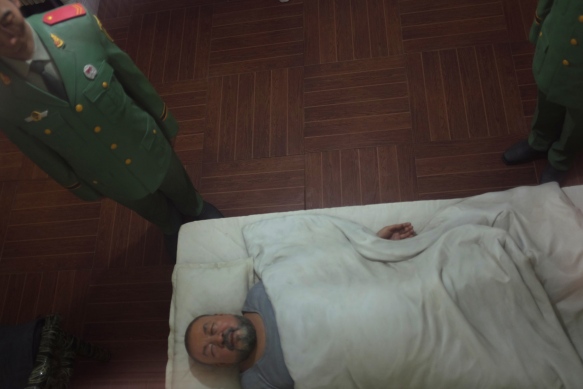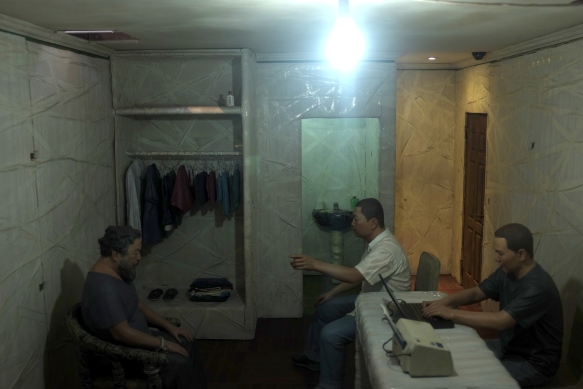Ai Weiwei, S.A.C.R.E.D., 2013 (installation view, Chiesa di Sant’Antonin, Venice as part of Disposition organised by Zuecca Projects and the Lisson Gallery)
Walking into a church in Venice and finding six large black crate-like boxes would be a fairly odd regardless but add couple of dozen other art lovers into the equation, wandering around the space and climbing on little black boxes to peer intently into the crates is a distinctly strange and somewhat unsettling experience. Like most churches in Venice, Chiesa di Sant’Antonin, a fourth century building extensively reworked in the Baroque style in the mid seventeenth century, has a rather ornate interior. The austere black boxes that dominate the floor of the space are an incongruous sight; once one gets beyond the immediate visual confusion, the context raises some interesting questions.
S.A.C.R.E.D. is the other half of Ai Weiwei’s exhibition Disposition (I wrote about Straight here yesterday), but this is an installation that tells a much more personal story than its counterpart in the Zuecca Project Space. It was his investigations into the Sichuan earthquake – the subject matter of Straight – that set Ai Weiwei at odds with the Chinese government; S.A.C.R.E.D. tells the story of what happened to the artist when he was arrested without warning in 2011 and held for 81 days under suspicion of ‘economic crimes’.
On his release, Ai indicated that he was not permitted to talk to the media – he even managed to stay away from Twitter for a while – so telling the story of his detention seems a risky strategy. To anyone who has read Barnaby Martin’s book Hanging Man: The Arrest of Ai Weiwei or seen Howard Brenton’s play The Arrest of Ai Weiwei, staged at the Hampstead Theatre in London last year, this is a familiar story, indeed the staging of Brenton’s play was such that the set bore a close relationship with Ai’s own installation, nonetheless there is something shocking about the experience of peering in to the fibreglass dioramas that inhabit the iron boxes and watching the guards watching the artist.
Ai is watched at all times by two guards. They watch him sleep, shower and shit; they watch him eat, they pace the cell alongside him as he exercises. The only time the guards are absent is when Ai is being questioned; then he is with his interrogator and a notetaker. The relentlessness of the scenes played out in these replicas of his cell is both powerful and draining but there’s an air of absurdity about the dioramas and the use of fibreglass that lightens the mood; it is never less than clear that we are looking at models – and here the larger than life artist is smaller than life-size.
There are lots of layers to peel back here, of course. Firstly there’s the voyeuristic fascination with watching and with examining every awful detail of the cell and its unpleasantly grubby toilet. The solidity of the cast iron boxes is all the more awe-inspiring in contrast with the flimsy appearance of the patched up interior space; in a way there are parallels here with the idea of human vulnerability in the face of the powerful machines of state. If Straight is Ai making a stand, using his position as a major international artist to speak out on behalf of others in his country whose voices can’t travel as easily, then S.A.C.R.E.D. is him facing the consequences of his actions.
Given his profile, Ai’s detention was never going to see him disappear without trace – his arrest was inevitably major news around the world – but the threat was very, very real and his experience of those 81 days can have been nothing less than terrifying. In that respect, S.A.C.R.E.D. is perhaps Ai’s nightmares made solid.





